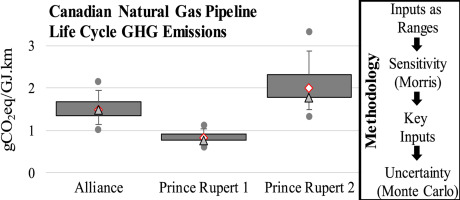当前位置:
X-MOL 学术
›
Gas Sci. Eng.
›
论文详情
Our official English website, www.x-mol.net, welcomes your
feedback! (Note: you will need to create a separate account there.)
Developing a Greenhouse Gas Life Cycle Assessment Framework for Natural Gas Transmission Pipelines
Gas Science and Engineering Pub Date : 2020-03-01 , DOI: 10.1016/j.jngse.2019.103136 Giovanni Di Lullo , Abayomi Olufemi Oni , Eskinder Gemechu , Amit Kumar
Gas Science and Engineering Pub Date : 2020-03-01 , DOI: 10.1016/j.jngse.2019.103136 Giovanni Di Lullo , Abayomi Olufemi Oni , Eskinder Gemechu , Amit Kumar

|
Abstract As demand for natural gas increases, it is important to understand its life cycle emission intensity. A framework is developed for performing bottom-up greenhouse gas (GHG) life cycle assessment of natural gas transmission pipelines to assist project environmental assessments. Three large-scale pipelines in Canada were examined: Alliance mainline (50 million m3/d, 3000 km), Prince Rupert phase 1 (PR1, 57 million m3/d, 878 km), and Prince Rupert phase 2 (PR2, 102 million m3/d, 878 km). Fundamental engineering principles are used for calculation accuracy, with a sensitivity analysis to identify key parameters. The model boundary includes pipeline construction, operation, and decommissioning. The resulting transportation GHG emission intensities are 1.49, 0.77, and 1.78 gCO2eq/GJ.km for the Alliance, PR1, and PR2 projects, respectively. The operating phase represents 78%–95% of the overall emissions. Operating at higher pressures could reduce emission intensity by up to 49% by increasing flow efficiency. The research provides a user-friendly open-source template that can be used to examine alternative scenarios.
中文翻译:

为天然气输送管道制定温室气体生命周期评估框架
摘要 随着对天然气需求的增加,了解其生命周期排放强度非常重要。开发了一个框架,用于对天然气输送管道进行自下而上的温室气体 (GHG) 生命周期评估,以协助项目环境评估。考察了加拿大的三条大型管道:Alliance 干线(5000 万立方米/天,3000 公里)、鲁珀特王子港一期(PR1,5700 万立方米/天,878 公里)和鲁珀特王子港二期(PR2,1.02 亿公里)立方米/天,878 公里)。基本工程原理用于计算精度,并通过敏感性分析来确定关键参数。模型边界包括管道建设、运行和退役。对于 Alliance、PR1 和 PR2 项目,由此产生的交通温室气体排放强度分别为 1.49、0.77 和 1.78 gCO2eq/GJ.km。运行阶段占总排放量的 78%–95%。通过提高流动效率,在更高压力下运行可以将排放强度降低多达 49%。该研究提供了一个用户友好的开源模板,可用于检查替代方案。
更新日期:2020-03-01
中文翻译:

为天然气输送管道制定温室气体生命周期评估框架
摘要 随着对天然气需求的增加,了解其生命周期排放强度非常重要。开发了一个框架,用于对天然气输送管道进行自下而上的温室气体 (GHG) 生命周期评估,以协助项目环境评估。考察了加拿大的三条大型管道:Alliance 干线(5000 万立方米/天,3000 公里)、鲁珀特王子港一期(PR1,5700 万立方米/天,878 公里)和鲁珀特王子港二期(PR2,1.02 亿公里)立方米/天,878 公里)。基本工程原理用于计算精度,并通过敏感性分析来确定关键参数。模型边界包括管道建设、运行和退役。对于 Alliance、PR1 和 PR2 项目,由此产生的交通温室气体排放强度分别为 1.49、0.77 和 1.78 gCO2eq/GJ.km。运行阶段占总排放量的 78%–95%。通过提高流动效率,在更高压力下运行可以将排放强度降低多达 49%。该研究提供了一个用户友好的开源模板,可用于检查替代方案。











































 京公网安备 11010802027423号
京公网安备 11010802027423号